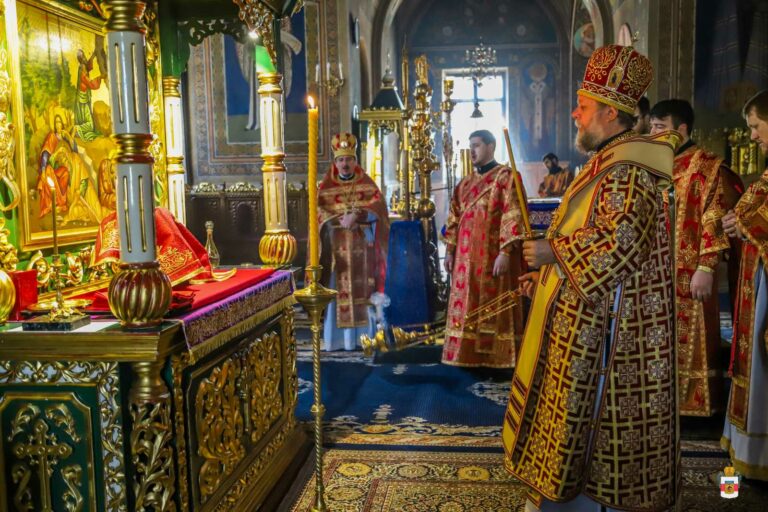Tuesday, 22 March 2022, the first hierarch of the Moldovan Church celebrated the Divine Service on the Feast of 40 Martyrs of Sebaste in the Chisinau Metropolitan Cathedral. According to the church rules, Liturgy of Pre-sanctified Gifts was officiated.
The arch-pastor was assisted at the service by archpriest Vadim Cheibas, Dean of the Cathedral, and clergy of the holy place.
Holy 40 Martyrs celebrated today witnessed their faith and received martyrdom in the town of Sebaste, Armenia, during the co-ruler of the Roman Emperor Licinius (307-323 A.D.).
Numerous church goers present at the service communed with the Body and Blood of Christ.
xxxxxxxxxxxxxxxxxxxxxxxxxxxxxxxxxxxxxxxxxxxxxxxxxxxxx
In the year 313 Saint Constantine the Great issued an edict, from which the christians were permitted freedom of belief and made equal with pagans under the law. But his co-ruler Licinius was prevailed upon by pagans, and in his part of the empire he decided to eradicate Christianity, which had become considerably widespread there. Licinius prepared his soldiery to fight against Constantine and, fearing mutiny, he decided to rid christians from his army.
One of the military-commanders of that time in the Armenian city of Sebasteia was Agricolaus, a zealous proponent of paganism. Under his command was a company of forty Cappadocians – brave soldiers – who emerged victorious from many a battle. All of them were christians. When these soldiers refused to offer sacrifice to the pagan gods, Agricolaus locked them up in prison. The soldiers immersed themselves in diligent prayer, and at one point during the night they heard a voice: “Persevere until the end, then shalt ye be saved”.
On the following morning the soldiers were again taken to Agricolaus. This time the pagan tried the method of flattery. He began to praise their valour, their youthfulness and strength; and again he urged them to renounce Christ and thereby win themselves the respect and favour of their emperor. And again hearing their refusal, Agricolaus gave orders to shackle the soldiers. But the eldest of them, Kyrion, said: “The emperor has not given thee the right to put shackles upon us”. Agricolaus became embarrassed and gave an order to take the soldiers back to prison without shackles.
Seven days later, the reknown judge Licius arrived at Sebasteia and held trial over the soldiers. The saints steadfastly answered: “Take not only our military insignia, but also our lives, since nothing is more precious to us than Christ God”. Licius thereupon ordered the holy martyrs to be beaten with stones. But the stones flew past them entirely; and the stone thrown by Licius, hit Agricolaus in the face. The torturers realised that the saints were guarded by some invisible force. In prison, the soldiers spent the night at prayer and again they heard the voice of the Lord comforting them: “Believing in Me, if anyone shalt die he shalt live. Be brave and fear not, since ye shall obtain crowns imperishable”.
On the following day also the judge repeated the interrogation in front of the torturer, but the soldiers remained unyielding.
It was winter, and there was a strong frost. They lined up the holy soldiers, led them to a lake located not far from the city, and placed them under guard on the ice all night. In order to break the will of the martyrs, a warm bath-house was set up not far away on the shore. During the first hour of the night, when the cold had become unbearable, one of the soldiers could not hold out and made a dash for the bath-house, but barely had he stepped over the threshold, that he fell down dead. During the third hour of the night the Lord sent consolation to the martyrs: suddenly there was light, the ice melted away, and the water in the lake became warm. All the guards were asleep, except for one who kept watch by the name of Aglaios. Looking at the lake he saw, that over the head of each martyr there had appeared a radiant crown. Aglaios counted thirty-nine crowns and realised, that the soldier who fled had lost his crown. Aglaios thereupon woke up the other guards, discarded his uniform and said to them: “I too – am a Christian” – and he joined the martyrs. Standing in the water he prayed: “Lord God, I believe in Thee, in Whom these soldiers do believe. To them add me also, and esteem me worthy to suffer with Thy servants”.
In the morning the torturers beheld with surprise that the martyrs were alive, and their guard Aglaios was glorifying Christ together with them. They then led the soldiers out of the water and broke their legs. At the time of this horrible execution the mother of the youngest of the soldiers, Meliton, pleaded with her son not to endure and suffer everything all the way to death. They put the bodies of the martyrs on a cart and committed them to fire. Young Meliton was still breathing, and they left him to lay on the ground. His mother then pulled up her son, and on her own shoulders she carried him behind the cart. When Meliton gasped out his last breath, his mother put him on the cart amidst the bodies of his fellow sufferers. The bodies of the saints were committed to fire, and they then threw the charred bones into the water, so that christians would not gather them up.
Three days later the martyrs appeared in a dream to Blessed Peter, bishop of Sebasteia, and commanded him to give their remains over to burial. The bishop together with several clergy gathered up the remains of the glorious martyrs by night and buried them with honour.
© 1996-2001 by translator Fr. S. Janos. (source: Holy Trinity Church in Baltimore)
Synodal Sector of Institutional Communication and Mass-Media Relations





